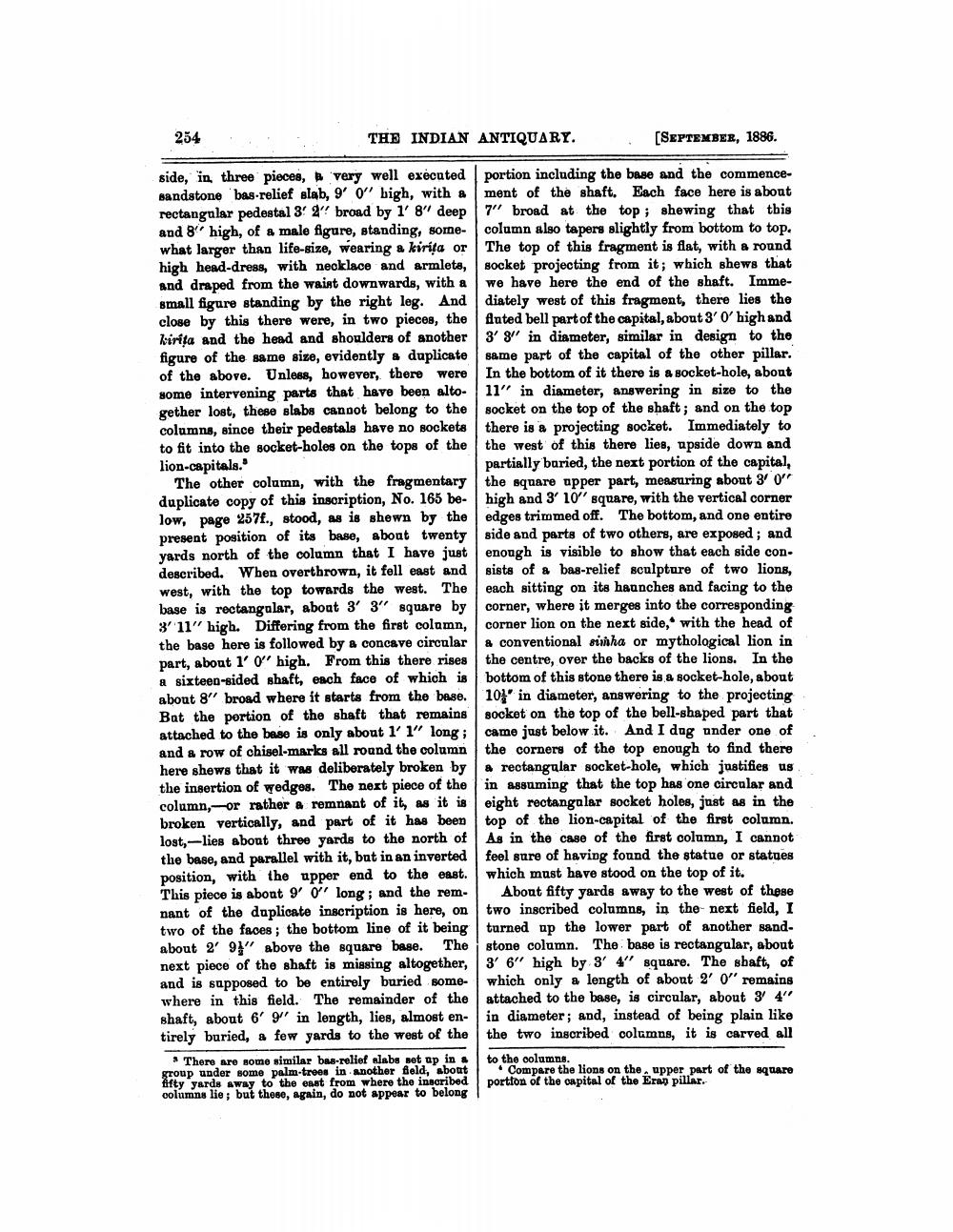________________
254
THE INDIAN ANTIQUARY.
side, in, three pieces, a very well executed sandstone bas-relief slab, 9' 0" high, with a rectangular pedestal 3' 2" broad by 1' 8" deep and 8 high, of a male figure, standing, somewhat larger than life-size, wearing a kirita or high head-dress, with necklace and armlets, and draped from the waist downwards, with a small figure standing by the right leg. And close by this there were, in two pieces, the kirita and the head and shoulders of another figure of the same size, evidently a duplicate of the above. Unless, however, there were some intervening parts that have been altogether lost, these slabs cannot belong to the columns, since their pedestals have no sockets to fit into the socket-holes on the tops of the lion-capitals."
The other column, with the fragmentary duplicate copy of this inscription, No. 165 below, page 257f., stood, as is shewn by the present position of its base, about twenty yards north of the column that I have just described. When overthrown, it fell east and west, with the top towards the west. The base is rectangular, about 3' 3" square by 3' 11" high. Differing from the first column, the base here is followed by a concave circular part, about 1' 0" high. From this there rises a sixteen-sided shaft, each face of which is about 8" broad where it starts from the base. Bat the portion of the shaft that remains attached to the base is only about 1' 1" long; and a row of chisel-marks all round the column here shews that it was deliberately broken by the insertion of wedges. The next piece of the column, or rather a remnant of it, as it is broken vertically, and part of it has been lost,-lies about three yards to the north of the base, and parallel with it, but in an inverted position, with the upper end to the east. This piece is about 9' 0" long; and the remnant of the duplicate inscription is here, on two of the faces; the bottom line of it being about 2 9 above the square base. The next piece of the shaft is missing altogether, and is supposed to be entirely buried somewhere in this field. The remainder of the shaft, about 6' 9" in length, lies, almost entirely buried, a few yards to the west of the
[SEPTEMBER, 1886.
portion including the base and the commencement of the shaft. Each face here is about 7" broad at the top; shewing that this column also tapers slightly from bottom to top. The top of this fragment is flat, with a round socket projecting from it; which shews that we have here the end of the shaft. Immediately west of this fragment, there lies the fluted bell part of the capital, about 3'0' high and 3' 3" in diameter, similar in design to the same part of the capital of the other pillar. In the bottom of it there is a socket-hole, about 11" in diameter, answering in size to the socket on the top of the shaft; and on the top there is a projecting socket. Immediately to the west of this there lies, upside down and partially buried, the next portion of the capital, the square upper part, measuring about 3' 0" high and 3′ 10′′ square, with the vertical corner edges trimmed off. The bottom, and one entire side and parts of two others, are exposed; and enough is visible to show that each side consists of a bas-relief sculpture of two lions, each sitting on its haunches and facing to the corner, where it merges into the corresponding corner lion on the next side, with the head of a conventional simha or mythological lion in the centre, over the backs of the lions. In the bottom of this stone there is a socket-hole, about 10" in diameter, answering to the projecting socket on the top of the bell-shaped part that came just below it. And I dug under one of the corners of the top enough to find there a rectangular socket-hole, which justifies us in assuming that the top has one circular and eight rectangular socket holes, just as in the top of the lion-capital of the first column. As in the case of the first column, I cannot feel sure of having found the statue or statues which must have stood on the top of it.
There are some similar bas-relief slabs set up in a group under some palm-trees in another field, about fifty yards away to the east from where the inscribed columns lie; but these, again, do not appear to belong
About fifty yards away to the west of these two inscribed columns, in the next field, I turned up the lower part of another sandstone column. The base is rectangular, about 3' 6" high by 3' 4" square. The shaft, of which only a length of about 2' 0" remains attached to the base, is circular, about 3' 4" in diameter; and, instead of being plain like the two inscribed columns, it is carved all to the columns.
Compare the lions on the upper part of the square portion of the capital of the Eran pillar.




